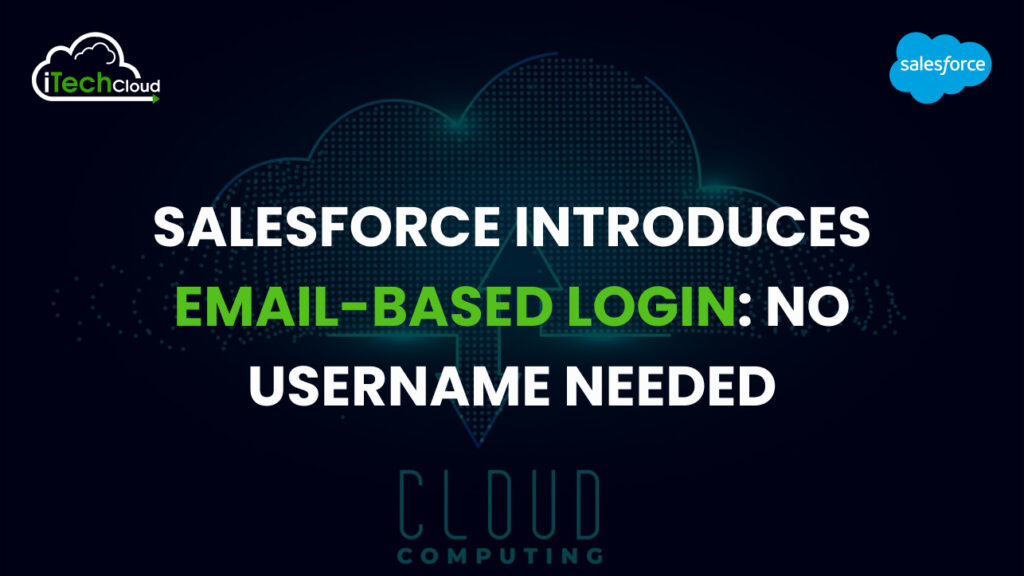Salesforce Introduces Email-Based Login: No Username Needed

Salesforce, the global leader in customer relationship management (CRM) solutions, has once again revolutionized the user experience with its latest innovation: email-based login, eliminating the need for a separate username. This update simplifies the authentication process, making it more intuitive and user-friendly while maintaining robust security standards.
Table of Contents
1. The Key Features of Salesforce Email-Based Login
Salesforce new login system allows users to sign in using just their email address, removing the requirement for a separate username. Here’s what this means in practice:
Simplified Authentication Process
- Users no longer need to remember multiple credentials (username + password).
- The login screen now only requires an email and password, streamlining access.
- Reduces login errors caused by forgotten usernames.
Seamless Integration with Existing Systems
- Works with Salesforce’s Single Sign-On (SSO) and multi-factor authentication (MFA).
- Compatible with Salesforce Authenticator and third-party security apps.
- No disruption for organizations using custom authentication protocols.
Backward Compatibility
- Existing usernames remain functional for backward compatibility.
- Admins can enforce email-only logins or allow both methods.
- No forced migration organizations can adopt the change at their own pace.
This update aligns with modern authentication trends seen in platforms like Google, Microsoft, and Apple, where email-based logins are the norm.
2. Why This Change Matters for Businesses and End Users
Improved User Experience (UX)
- Fewer Login Frictions: Users often struggle with remembering multiple credentials. Email-based login reduces friction.
- Faster Onboarding: New employees or customers can log in immediately without configuring a separate username.
- Consistency Across Platforms: Matches the login experience of other major SaaS products.
Reduced IT and Helpdesk Burden
- Fewer “forgot username” support tickets.
- Lower training costs for new users unfamiliar with Salesforce’s legacy login system.
- Streamlined password recovery (since email is the primary identifier).
Enhanced Adoption Rates
- A simpler login process can improve user adoption, especially for non-technical teams.
- Reduces barriers for external stakeholders (partners, clients) accessing Salesforce portals.
3. Security Implications and Enhancements
A common concern when simplifying authentication is security. However, Salesforce has ensured that this change does not compromise safety.
Multi-Factor Authentication (MFA) Remains Strong
- Email-based login works seamlessly with MFA, ensuring an additional security layer.
- Salesforce Authenticator, SMS codes, and biometric verification remain fully supported.
Protection Against Phishing & Credential Stuffing
- Since emails are often public, Salesforce enforces IP restrictions, suspicious login detection, and rate limiting.
- Admins can enforce password policies (complexity, expiration) to mitigate risks.
No Impact on Single Sign-On (SSO) or SAML
- Enterprises using SSO (like Okta or Microsoft Azure AD) will see no disruption.
- SAML and OAuth integrations continue to work as before.
4. How This Compares to Traditional Login Methods
Traditional Salesforce Login (Username + Password)
✅ Pros:
- Unique usernames provided an extra layer of obscurity (security through obscity).
- Some organizations preferred custom usernames for internal policies.
❌ Cons:
- Users often forgot usernames, leading to support tickets.
- Added complexity for new users.
New Email-Based Login
✅ Pros:
- Easier to remember (users already know their email).
- Aligns with modern authentication standards.
- Reduces login friction without sacrificing security.
❌ Cons:
- If an email is compromised, attackers have half the credentials. (Mitigated by MFA.)
- Requires admins to ensure email addresses are up to date in Salesforce.
5. Step-by-Step Guide to Transitioning to Email-Based Login
For Salesforce admins looking to implement this change, here’s a step-by-step guide:
Step 1: Verify Email Addresses in User Profiles
- Ensure all users have a valid, unique email in Salesforce.
- Run a data quality report to check for duplicates or outdated emails.
Step 2: Enable Email-Based Login in Setup
- Navigate to Setup > Security Controls > Login Policies.
- Toggle “Allow Email-Based Logins.”
- Optionally, enforce “Disable Username Logins” for full migration.
Step 3: Communicate the Change to Users
- Send an announcement explaining the new login process.
- Provide training if needed (though the change is intuitive).
Step 4: Monitor Login Activity
- Use Login Forensics to track any failed attempts.
- Ensure MFA adoption remains high.
6. Potential Challenges and Considerations
Challenge 1: Duplicate or Inactive Emails
- If two users share an email (e.g., generic support@company.com), conflicts arise.
- Solution: Enforce unique emails and clean up inactive accounts.
Challenge 2: User Resistance to Change
- Some users may be accustomed to usernames.
- Solution: Allow a transition period where both methods work.
Challenge 3: Security Training
- Users must understand that email-based login does not mean weaker security.
- Solution: Reinforce MFA and phishing awareness training.
7. Future Trends in Authentication and User Experience
Salesforce’s move reflects broader trends in digital identity:
Passwordless Authentication
- Biometrics (Face ID, Touch ID) and WebAuthn are gaining traction.
- Salesforce may integrate FIDO2 standards in the future.
Decentralized Identity (Blockchain-Based Logins)
- Self-sovereign identity (SSI) could allow users to control their credentials without emails.
AI-Powered Fraud Detection
- Salesforce Einstein can enhance login security with behavioral biometrics (keystroke dynamics, mouse movements).
Conclusion
Salesforce’s introduction of email-based login is a strategic move that enhances usability without compromising security. By eliminating the need for usernames, Salesforce reduces friction, improves adoption, and aligns with modern authentication trends.

